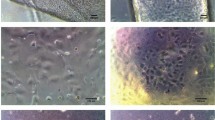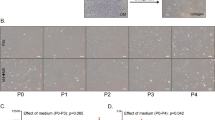Abstract
Dysfunction of the corneal endothelium reduces the transparency of the cornea and can cause blindness. Because corneal endothelial cells have an extremely limited proliferative ability in vivo, treatment for corneal endothelial dysfunction involves the transplantation of donor corneal tissue. Corneal endothelium can also be restored via intraocular injection of endothelial cells in suspension after their expansion in vitro. Yet, because quality assessment during the expansion of the cells is a destructive process, a substantial number of the cultured cells are lost. Here, we show that the ‘spring constant’ of the effective interaction potential between endothelial cells in a confluent monolayer serves as a biomarker of the quality of corneal endothelial cells in vitro and of the long-term prognosis of corneal restoration in patients treated with culture-expanded endothelial cells or with transplanted corneas. The biomarker can be measured from phase contrast imaging in vitro and from specular microscopy in vivo, and may enable a shift from passive monitoring to pre-emptive intervention in patients with severe corneal disorders.
This is a preview of subscription content, access via your institution
Access options
Access Nature and 54 other Nature Portfolio journals
Get Nature+, our best-value online-access subscription
$29.99 / 30 days
cancel any time
Subscribe to this journal
Receive 12 digital issues and online access to articles
$99.00 per year
only $8.25 per issue
Buy this article
- Purchase on Springer Link
- Instant access to full article PDF
Prices may be subject to local taxes which are calculated during checkout






Similar content being viewed by others
Data availability
The authors declare that the main data supporting the results in this study are available within the paper and its Supplementary Information. The raw and analysed datasets generated during the study are available for research purposes from the corresponding authors on reasonable request.
Code availability
All Igor codes in this work are available from the corresponding authors on reasonable request.
References
Dawson, D. G., Ubels, J. L. & Edelhauser, H. F. Adler’s Physiology of the Eye 71–130 (Elsevier, 2011).
Kinoshita, S. et al. Grading for corneal endothelial damage. Jpn. J. Ophthalmol. 118, 3 (2014).
Bourne, W. M. Clinical estimation of corneal endothelial pump function. Trans. Am. Ophthalmol. Soc. 96, 229–242 (1998).
Gain, P. et al. Global survey of corneal transplantation and eye banking. JAMA Ophthalmol. 134, 167–173 (2016).
Rahman, I., Carley, F., Hillarby, C., Brahma, A. & Tullo, A. B. Penetrating keratoplasty: indications, outcomes, and complications. Eye 23, 1288–1294 (2009).
Terry, M. A. & Ousley, P. J. Deep lamellar endothelial keratoplasty visual acuity, astigmatism, and endothelial survival in a large prospective series. Ophthalmology 112, 1541–1548 (2005).
Melles, G. R., Wijdh, R. H. & Nieuwendaal, C. P. A technique to excise the Descemet membrane from a recipient cornea (descemetorhexis). Cornea 23, 286–288 (2004).
Melles, G. R., Ong, T. S., Ververs, B. & van der Wees, J. Descemet membrane endothelial keratoplasty (DMEK). Cornea 25, 987–990 (2006).
Tan, D. T. H., Dart, J. K. G., Holland, E. J. & Kinoshita, S. Corneal transplantation. Lancet 379, 1749–1761 (2012).
2015 Eye Banking Statistical Report (Eye Bank Association of America, 2016).
Melles, G. R. J., Ong, T. S., Ververs, B. & van der Wees, J. Preliminary clinical results of Descemet membrane endothelial keratoplasty. Am. J. Ophthalmol. 145, 222–227.e1 (2008).
Price, M. O., Giebel, A. W., Fairchild, K. M. & Price, F. W. Descemet’s membrane endothelial keratoplasty: prospective multicenter study of visual and refractive outcomes and endothelial survival. Ophthalmology 116, 2361–2368 (2009).
Schlögl, A., Tourtas, T., Kruse, F. E. & Weller, J. M. Long-term clinical outcome after Descemet membrane endothelial keratoplasty. Am. J. Ophthalmol. 169, 218–226 (2016).
Wacker, K., Baratz, K. H., Maguire, L. J., McLaren, J. W. & Patel, S. V. Descemet stripping endothelial keratoplasty for Fuchs’ endothelial corneal dystrophy: five-year results of a prospective study. Ophthalmology 123, 154–160 (2016).
Okumura, N. et al. Enhancement on primate corneal endothelial cell survival in vitro by a ROCK inhibitor. Invest. Ophthalmol. Vis. Sci. 50, 3680–3687 (2009).
Kinoshita, S. et al. Cultured corneal endothelial cell injection therapy for bullous keratopathy. N. Eng. J. Med. 378, 995–1003 (2018).
Toda, M. et al. Production of homogeneous cultured human corneal endothelial cells indispensable for innovative cell therapy. Invest. Ophthalmol. Vis. Sci. 58, 2011–2020 (2017).
Hamuro, J. et al. Cultured human corneal endothelial cell aneuploidy dependence on the presence of heterogeneous subpopulations with distinct differentiation phenotypes. Invest. Ophthalmol. Vis. Sci. 57, 4385–4392 (2016).
Hamuro, J. et al. Cell homogeneity indispensable for regenerative medicine by cultured human corneal endothelial cells. Invest. Ophthalmol. Vis. Sci. 57, 4749–4761 (2016).
McCarey, B. E. Noncontact specular microscopy: a macrophotography technique and some endothelial cell findings. Ophthalmology 86, 1848–1860 (1979).
Tanaka, H. et al. Panoramic view of human corneal endothelial cell layer observed by a prototype slit-scanning wide-field contact specular microscope. Br. J. Ophthalmol. 101, 655–659 (2017).
McCarey, B. E., Edelhauser, H. F. & Lynn, M. J. Review of corneal endothelial specular microscopy for FDA clinical trials of refractive procedures, surgical devices, and new intraocular drugs and solutions. Cornea 27, 1–16 (2008).
Doughty, M. J. Toward a quantitative analysis of corneal endothelial cell morphology: a review of techniques and their application. Optom. Vis. Sci. 66, 626–642 (1989).
Okumura, N. et al. Development of cell analysis software for cultivated corneal endothelial cells. Cornea 36, 1387–1394 (2017).
Veschgini, M. et al. Size, shape, and lateral correlation of highly uniform, mesoscopic, self-assembled domains of fluorocarbon–hydrocarbon diblocks at the air/water interface: a GISAXS study. ChemPhysChem 18, 2791–2798 (2017).
Ramos, L., Lubensky, T. C., Dan, N., Nelson, P. & Weitz, D. A. Surfactant-mediated two-dimensional crystallization of colloidal crystals. Science 286, 2325–2328 (1999).
Wickman, H. H. & Korley, J. N. Colloid crystal self-organization and dynamics at the air/water interface. Nature 393, 445–447 (1998).
Brookes, N. H. Riding the cell jamming boundary: geometry, topology, and phase of human corneal endothelium. Exp. Eye Res. 172, 171–180 (2018).
Park, C. Y., Lee, J. K., Gore, P. K., Lim, C. Y. & Chuck, R. S. Keratoplasty in the United States: a 10-year review from 2005 through 2014. Ophthalmology 122, 2432–2442 (2015).
Harrison, T. A. et al. Corneal endothelial cells possess an elaborate multipolar shape to maximize the basolateral to apical membrane area. Mol. Vis. 22, 31–39 (2016).
Swets, J. A. Measuring the accuracy of diagnostic systems. Science 240, 1285–1293 (1988).
Egan, J. P. Signal Detection Theory and ROC Analysis (Academic Press, 1975).
Fawcett, T. An introduction to ROC analysis. Pattern Recognit. Lett. 27, 861–874 (2006).
Acknowledgements
We thank the Baptist Eye Institute for access to the clinical records, H. Nakagawa for data collection, K. Yoshikawa for stimulating discussions, and J. Bush for reviewing the manuscript. This work was supported by Nakatani Foundation (M.Tanaka and M.U.), JSPS (17H00855 to M.Tanaka; 16K05515 to A.Y.), MEXT (16KT0070 to M.Tanaka), the Highway Program for Realization of Regenerative Medicine of the Japan Agency for Medical Research and Development (S.K.) and the Research Project for Practical Applications of Regenerative Medicine of the Japanese Ministry of Health, Labor and Welfare (S.K.).
Author information
Authors and Affiliations
Contributions
M.U. and M.Tanaka conceived and directed the research. A.Y. and H.T. performed the research and analysis. M.Toda collected the data. C.S. and S.K. supervised the retrospective analysis of clinical research. A.Y., H.T., J.H., S.K., M.U. and M.Tanaka wrote the paper.
Corresponding authors
Ethics declarations
Competing interests
The authors declare no competing interests.
Additional information
Publisher’s note: Springer Nature remains neutral with regard to jurisdictional claims in published maps and institutional affiliations.
Supplementary information
Supplementary Information
Supplementary figures
Rights and permissions
About this article
Cite this article
Yamamoto, A., Tanaka, H., Toda, M. et al. A physical biomarker of the quality of cultured corneal endothelial cells and of the long-term prognosis of corneal restoration in patients. Nat Biomed Eng 3, 953–960 (2019). https://doi.org/10.1038/s41551-019-0429-9
Received:
Accepted:
Published:
Issue Date:
DOI: https://doi.org/10.1038/s41551-019-0429-9
This article is cited by
-
A single-cell RNA-seq analysis unravels the heterogeneity of primary cultured human corneal endothelial cells
Scientific Reports (2023)
-
Higher-order mesoscopic self-assembly of fluorinated surfactants on water surfaces
NPG Asia Materials (2023)
-
Quiescent innate and adaptive immune responses maintain the long-term integrity of corneal endothelium reconstituted through allogeneic cell injection therapy
Scientific Reports (2022)
-
Transcriptome dataset of human corneal endothelium based on ribosomal RNA-depleted RNA-Seq data
Scientific Data (2020)
-
A prognostic biomarker of corneal repair
Nature Biomedical Engineering (2019)



